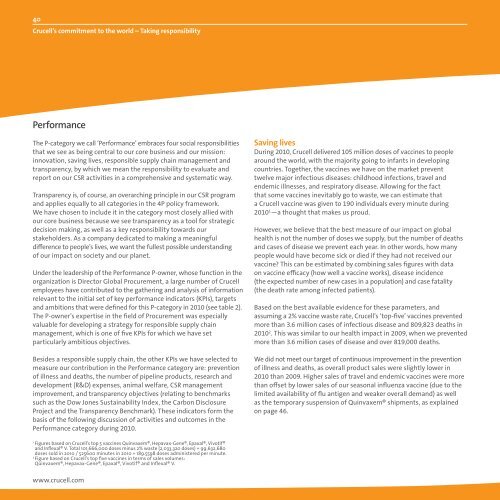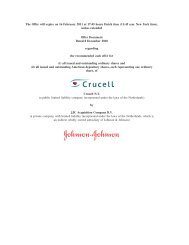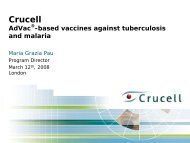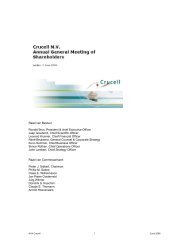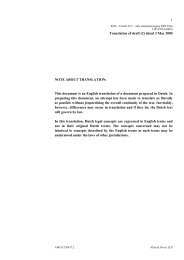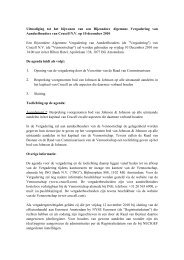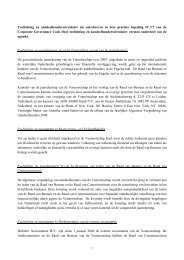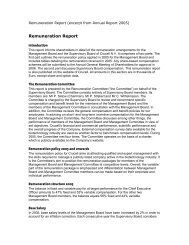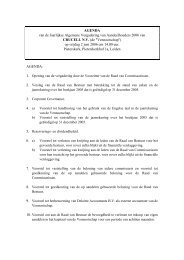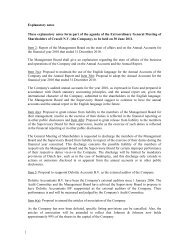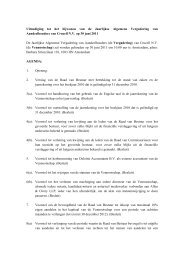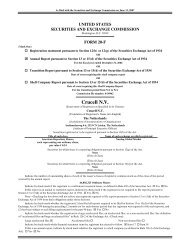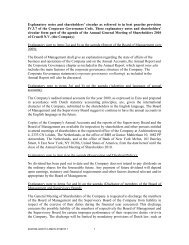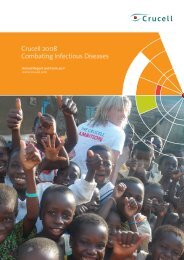Crucell corporate brochure (PDF)
Crucell corporate brochure (PDF)
Crucell corporate brochure (PDF)
You also want an ePaper? Increase the reach of your titles
YUMPU automatically turns print PDFs into web optimized ePapers that Google loves.
40<br />
<strong>Crucell</strong>’s commitment to the world – Taking responsibility<br />
Performance<br />
The P-category we call ‘Performance’ embraces four social responsibilities<br />
that we see as being central to our core business and our mission:<br />
innovation, saving lives, responsible supply chain management and<br />
transparency, by which we mean the responsibility to evaluate and<br />
report on our CSR activities in a comprehensive and systematic way.<br />
Transparency is, of course, an overarching principle in our CSR program<br />
and applies equally to all categories in the 4P policy framework.<br />
We have chosen to include it in the category most closely allied with<br />
our core business because we see transparency as a tool for strategic<br />
decision making, as well as a key responsibility towards our<br />
stakeholders. As a company dedicated to making a meaningful<br />
difference to people’s lives, we want the fullest possible understanding<br />
of our impact on society and our planet.<br />
Under the leadership of the Performance P-owner, whose function in the<br />
organization is Director Global Procurement, a large number of <strong>Crucell</strong><br />
employees have contributed to the gathering and analysis of information<br />
relevant to the initial set of key performance indicators (KPIs), targets<br />
and ambitions that were defined for this P-category in 2010 (see table 2).<br />
The P-owner’s expertise in the field of Procurement was especially<br />
valuable for developing a strategy for responsible supply chain<br />
management, which is one of five KPIs for which we have set<br />
particularly ambitious objectives.<br />
Besides a responsible supply chain, the other KPIs we have selected to<br />
measure our contribution in the Performance category are: prevention<br />
of illness and deaths, the number of pipeline products, research and<br />
development (R&D) expenses, animal welfare, CSR management<br />
improvement, and transparency objectives (relating to benchmarks<br />
such as the Dow Jones Sustainability Index, the Carbon Disclosure<br />
Project and the Transparency Benchmark). These indicators form the<br />
basis of the following discussion of activities and outcomes in the<br />
Performance category during 2010.<br />
1 Figures based on <strong>Crucell</strong>’s top 5 vaccines Quinvaxem®, Hepavax-Gene®, Epaxal®, Vivotif®<br />
and Inflexal® V. Total 101,666,000 doses minus 2% waste (2,033,320 doses) = 99,632,680<br />
doses sold in 2010 / 525600 minutes in 2010 = 189.5598 doses administered per minute.<br />
2 Figure based on <strong>Crucell</strong>’s top five vaccines in terms of sales volumes:<br />
Quinvaxem®, Hepavax-Gene®, Epaxal®, Vivotif® and Inflexal® V.<br />
www.crucell.com<br />
Saving lives<br />
During 2010, <strong>Crucell</strong> delivered 105 million doses of vaccines to people<br />
around the world, with the majority going to infants in developing<br />
countries. Together, the vaccines we have on the market prevent<br />
twelve major infectious diseases: childhood infections, travel and<br />
endemic illnesses, and respiratory disease. Allowing for the fact<br />
that some vaccines inevitably go to waste, we can estimate that<br />
a <strong>Crucell</strong> vaccine was given to 190 individuals every minute during<br />
2010 1 —a thought that makes us proud.<br />
However, we believe that the best measure of our impact on global<br />
health is not the number of doses we supply, but the number of deaths<br />
and cases of disease we prevent each year. In other words, how many<br />
people would have become sick or died if they had not received our<br />
vaccine? This can be estimated by combining sales figures with data<br />
on vaccine efficacy (how well a vaccine works), disease incidence<br />
(the expected number of new cases in a population) and case fatality<br />
(the death rate among infected patients).<br />
Based on the best available evidence for these parameters, and<br />
assuming a 2% vaccine waste rate, <strong>Crucell</strong>’s ‘top-five’ vaccines prevented<br />
more than 3.6 million cases of infectious disease and 809,823 deaths in<br />
2010 2 . This was similar to our health impact in 2009, when we prevented<br />
more than 3.6 million cases of disease and over 819,000 deaths.<br />
We did not meet our target of continuous improvement in the prevention<br />
of illness and deaths, as overall product sales were slightly lower in<br />
2010 than 2009. Higher sales of travel and endemic vaccines were more<br />
than offset by lower sales of our seasonal influenza vaccine (due to the<br />
limited availability of flu antigen and weaker overall demand) as well<br />
as the temporary suspension of Quinvaxem® shipments, as explained<br />
on page 46.


